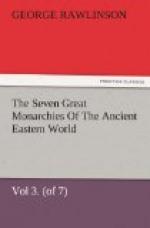Discarding then the Assyrian notion of a syllabarium, with the enormous complication which it involves, the Medes strove to reduce sounds to their ultimate elements, and to represent these last alone by symbols. Contenting themselves with the three main vowel sounds, a,i, and u, and with one breathing, a simple h, they recognized twenty consonants, which were the following, b,d,f,g,j,k,kh,m,n,n (sound doubtful), p,r,s,sh,t,v,y,z,ch (as in much), and tr, an unnecessary compound. Had they stopped here, their characters should have been but twenty-four, the number which is found in Greek. To their ears, however, it would seem, each consonant appeared to carry with it a short a, and as this, occurring before i and u, produced the diphthongs ai and au, sounded nearly as e and o, it seemed necessary, where a consonant was to be directly followed by the sounds i or u, to have special forms to which the sound of a should not attach. This system, carried out completely, would have raised the forms of consonants to sixty, a multiplication that was feared as inconvenient. In order to keep down the number, it seems to have been resolved, that one form should suffice for the aspirated letters and the sibilants (viz., h,kh; ch,ph or f,s,sh, and z), and also for b,y, and tr; that two forms should suffice for the tenues, k,p,t, for the liquids n and r, and for v; and consequently that the full number of three forms should be limited to some three or four letters, as d, m, j, and perhaps g. The result is that the known alphabet of the Persians, which is assumed here to have been the invention of the Medes, consists of some thirty-six or thirty-seven forms, which are really representative of no more than twenty-three distinct sounds.
It appears then that, compared with the phonetic systems in vogue among their neighbors, the alphabet of the Medes and Persians was marked by a great simplicity. The forms of the letters were also very much simplified. Instead of conglomerations of fifteen or sixteen wedges in a single character, we have in the Medo-Persic letters a maximum of five wedges. The most ordinary number is four, which is sometimes reduced to three




